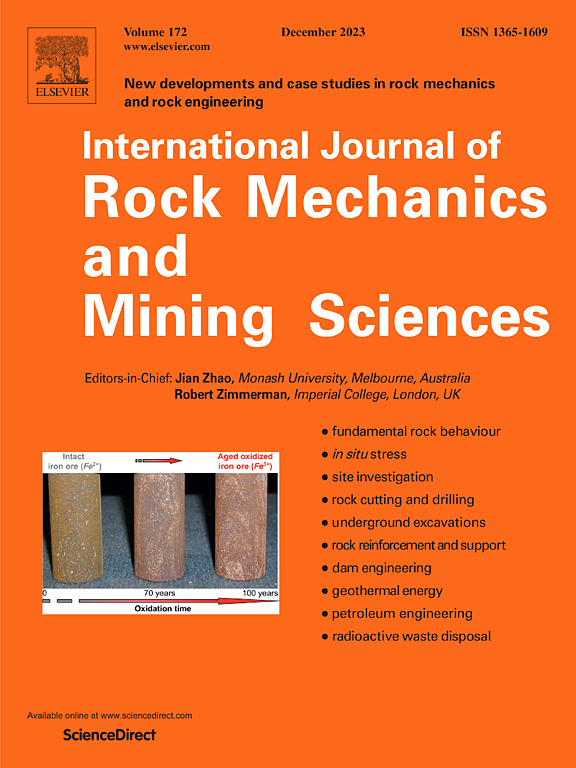准脆性岩石基于扩展黏结横向变形的周动力学模型
IF 7
1区 工程技术
Q1 ENGINEERING, GEOLOGICAL
International Journal of Rock Mechanics and Mining Sciences
Pub Date : 2025-04-04
DOI:10.1016/j.ijrmms.2025.106099
引用次数: 0
摘要
基于键的周动力学在描述和模拟岩体等连续-非连续问题方面具有重要的潜力。然而,目前发展起来的考虑粘结拉伸和剪切机制的理论对粘结力的预测不合理,当泊松比超过临界值时出现负剪切刚度。在这项工作中,确定了负剪切刚度问题背后的根本原因,并通过最初结合横向变形的影响以及粘结拉伸和旋转来解决。这样,环动力键的弹性响应就完成了,并变成了多维的。此外,键尺度公式可以看作是广义胡克定律的非局部版本。建立了一种能够描述岩石变形和混合模式断裂过程的基于粘结的多维周动力学模型。通过几个基准测试来评估该方法的有效性和鲁棒性。该模型不仅克服了传统模型在理论上的不足,而且能够更合适地描述和模拟岩石在不同尺度上的行为。本文章由计算机程序翻译,如有差异,请以英文原文为准。
An extended bond-based peridynamic model with bond transverse deformation effects for quasi-brittle rocks
The bond-based peridynamics shows significant potential in describing and simulating the continuous-discontinuous problems like rock mass. However, the theory developed so far with account of the bond stretch and shear mechanisms exhibits unreasonable prediction of bond force and the appearance of negative shear stiffness when Poisson’s ratio exceeds a critical value. In this work, the root cause behind the negative shear stiffness problems is identified and solved by originally incorporating the effect of transverse deformation in addition to the bond stretch and rotation. In this way, the elastic response of peridynamic bond is completed and becomes multi-dimensional. Also, the bond-scale formulations can be regarded as a nonlocal version of the generalized Hooke’s Law. A novel multi-dimensional bond-based peridynamic model is developed, which is capable of describing rock deformation and mixed-mode fracture process. Several benchmark tests are performed to assess the effectiveness and robustness of the method. The proposed model not only overcomes the theoretical deficiency of traditional ones but also allows more suitable description and simulation of rock behavior on different scales.
求助全文
通过发布文献求助,成功后即可免费获取论文全文。
去求助
来源期刊
CiteScore
14.00
自引率
5.60%
发文量
196
审稿时长
18 weeks
期刊介绍:
The International Journal of Rock Mechanics and Mining Sciences focuses on original research, new developments, site measurements, and case studies within the fields of rock mechanics and rock engineering. Serving as an international platform, it showcases high-quality papers addressing rock mechanics and the application of its principles and techniques in mining and civil engineering projects situated on or within rock masses. These projects encompass a wide range, including slopes, open-pit mines, quarries, shafts, tunnels, caverns, underground mines, metro systems, dams, hydro-electric stations, geothermal energy, petroleum engineering, and radioactive waste disposal. The journal welcomes submissions on various topics, with particular interest in theoretical advancements, analytical and numerical methods, rock testing, site investigation, and case studies.

 求助内容:
求助内容: 应助结果提醒方式:
应助结果提醒方式:


